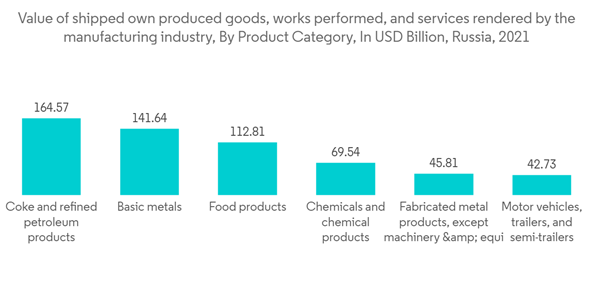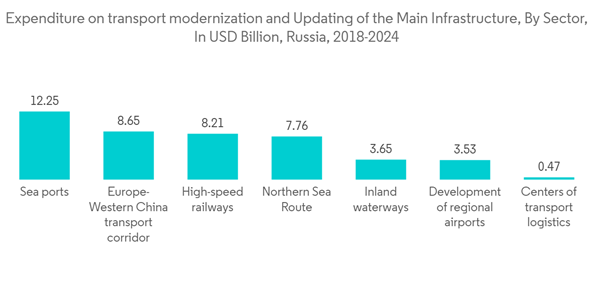The Russia Metal Fabrication Market size is estimated at USD 3.60 billion in 2024, and is expected to reach USD 4.44 billion by 2029, growing at a CAGR of 4.31% during the forecast period (2024-2029).
Coke and refined petroleum products had the largest production value among manufacturing segments in Russia, measured at approximately 12.5 trillion Russian rubles (USD 0.17 Trillion) in 2021. Basic metals were the second-leading category, at over 10.7 trillion Russian rubles (USD 0.14 Trillion). Russia's food production value exceeded 8.5 trillion Russian rubles (USD 0.11 Trillion), according to the Russian Federal State Statistics Service.
Some of the major pharma companies like Pfizer, Johnson & Johnson, Novartis, and Abbott are among the drugmakers that manufacture pharmaceutical drugs at facilities in St. Petersburg and elsewhere in the country and typically sell those drugs as branded generics or under Russian brands. This has accelerated the manufacturing sector and thus the substantial need for metal pieces of machinery and fabrication in the country.
The Russian government has set aside USD 1.78 billion for the construction of new highway links. The most significant of these projects will be the construction of the new M12 highway, which will connect Moscow with Kazan and pass through Nizhny Novgorod. Other significant projects include new sections of the M4 Don highway, a 51-kilometer bypass around Krasnodar, and a 67-kilometer bypass around Aksaya. Work on the USD 266.5 million bypass around Novorossiysk will begin in 2022 and is expected to be completed by 2023.
Furthermore, the Russian government is focusing on transportation infrastructure modernization. RUB 6.3 trillion (USD 0.084 trillion) was issued as part of a comprehensive plan to upgrade the country's highways, airports, railways, ports, and other transportation infrastructure. Furthermore, the Russian government has allocated RUB 4.8 trillion (USD 66.6 billion) to the "Safe and High-Quality Highways" project. These projects improve regional road connectivity in Russia.
However, the government intends to build 6,835 miles (11,000 kilometers) of new railroad tracks by 2030, connecting the cities of Moscow, St. Petersburg, Samara, Krasnodar, and Novosibirsk. Furthermore, the Russian railway network is seeing a surge in construction activity under the direction of the rail monopoly RZD. RZD was building 12,427 miles (20,000 km) of roads that were expected to be finished by 2030 and cost more than USD 61 billion.
This product will be delivered within 2 business days.
Key Highlights
- COVID-19 caused operational problems and low demand, which hurt the metal fabrication industry in Russia a lot. In the forecast period, production was expected to slowly get back to where it was before the pandemic.According to the industry association, domestic demand for metals would take a significant hit, and it would take at least 2022-2023 to return to pre-pandemic levels.
- Steel, which is an alloy of iron, carbon, and sometimes other things, is an important part of Russian ferrous metallurgy.Russia is fifth in the world in terms of monthly crude steel production, after China, India, Japan, and the United States. This is because the Soviet Union left Russia with a strong steel industry.
- The studied market, which is the Russian metal fabrication market, is made up of a large number of small and medium-sized businesses as well as EPC firms. The market is driven by the rising demand for goods and services in different parts of the country. On the other hand, Russia's invasion of Ukraine has affected the economy in the near term and promises to have a significant impact on the newly formed sheet metal industry. Even if the attack de-escalates, political uncertainty and economic sanctions will still affect the global economy.
Russia Metal Fabrication Market Trends
Increasing Number of Manufacturing Plants in Russia
Some of the major manufacturing sectors in Russia are Machine Manufacturing, chemicals, textile and light industry, and the Automotive sector. Though the manufacturing sector in Russia has been greatly affected as a result of the Russia-Ukraine war, many companies have a strong footprint in the Russian Manufacturing sector.Coke and refined petroleum products had the largest production value among manufacturing segments in Russia, measured at approximately 12.5 trillion Russian rubles (USD 0.17 Trillion) in 2021. Basic metals were the second-leading category, at over 10.7 trillion Russian rubles (USD 0.14 Trillion). Russia's food production value exceeded 8.5 trillion Russian rubles (USD 0.11 Trillion), according to the Russian Federal State Statistics Service.
Some of the major pharma companies like Pfizer, Johnson & Johnson, Novartis, and Abbott are among the drugmakers that manufacture pharmaceutical drugs at facilities in St. Petersburg and elsewhere in the country and typically sell those drugs as branded generics or under Russian brands. This has accelerated the manufacturing sector and thus the substantial need for metal pieces of machinery and fabrication in the country.
Increasing Transportation Infrastructure Development Activities in Russia are boosting the Market.
Russia has announced plans for a massive infrastructure expansion program. Russia intends to invest 400 billion roubles (USD 6.8 billion) from its National Wealth Fund in the year 2022, in addition to the 535 billion roubles (USD 7.10 billion) it has previously spent to maintain financial stability.The Russian government has set aside USD 1.78 billion for the construction of new highway links. The most significant of these projects will be the construction of the new M12 highway, which will connect Moscow with Kazan and pass through Nizhny Novgorod. Other significant projects include new sections of the M4 Don highway, a 51-kilometer bypass around Krasnodar, and a 67-kilometer bypass around Aksaya. Work on the USD 266.5 million bypass around Novorossiysk will begin in 2022 and is expected to be completed by 2023.
Furthermore, the Russian government is focusing on transportation infrastructure modernization. RUB 6.3 trillion (USD 0.084 trillion) was issued as part of a comprehensive plan to upgrade the country's highways, airports, railways, ports, and other transportation infrastructure. Furthermore, the Russian government has allocated RUB 4.8 trillion (USD 66.6 billion) to the "Safe and High-Quality Highways" project. These projects improve regional road connectivity in Russia.
However, the government intends to build 6,835 miles (11,000 kilometers) of new railroad tracks by 2030, connecting the cities of Moscow, St. Petersburg, Samara, Krasnodar, and Novosibirsk. Furthermore, the Russian railway network is seeing a surge in construction activity under the direction of the rail monopoly RZD. RZD was building 12,427 miles (20,000 km) of roads that were expected to be finished by 2030 and cost more than USD 61 billion.
Russia Metal Fabrication Industry Overview
The Russian metal fabrication market is fragmented by nature, with the presence of a large number of small- and medium-sized companies and EPC companies. The majority of the large fabricators present in the market studied are majorly EPC companies, which handle end-to-end solutions for structural steel fabrication and process equipment fabrication services. Some of the major players in the market are Severstal-Metiz, Novolipetsk Steel (NLMK), Magnitogorsk Iron and Steel Works, Lenmontag, and Metalloinvest Management Company LLC.Additional Benefits:
- The market estimate (ME) sheet in Excel format
- 3 months of analyst support
This product will be delivered within 2 business days.
Table of Contents
1 INTRODUCTION
4 MARKET DYNAMICS
5 MARKET SEGMENTATION
6 COMPETITIVE LANDSCAPE
Companies Mentioned (Partial List)
A selection of companies mentioned in this report includes, but is not limited to:
- Severstal-metiz
- Novolipetsk Steel (NLMK)
- Magnitogorsk Iron and Steel Works
- Lenmontag
- Metalloinvest Management Company LLC
- Mechel
- Ruspolimet
- Pic Metall
- Evraz Group
- TMK*
Methodology

LOADING...










